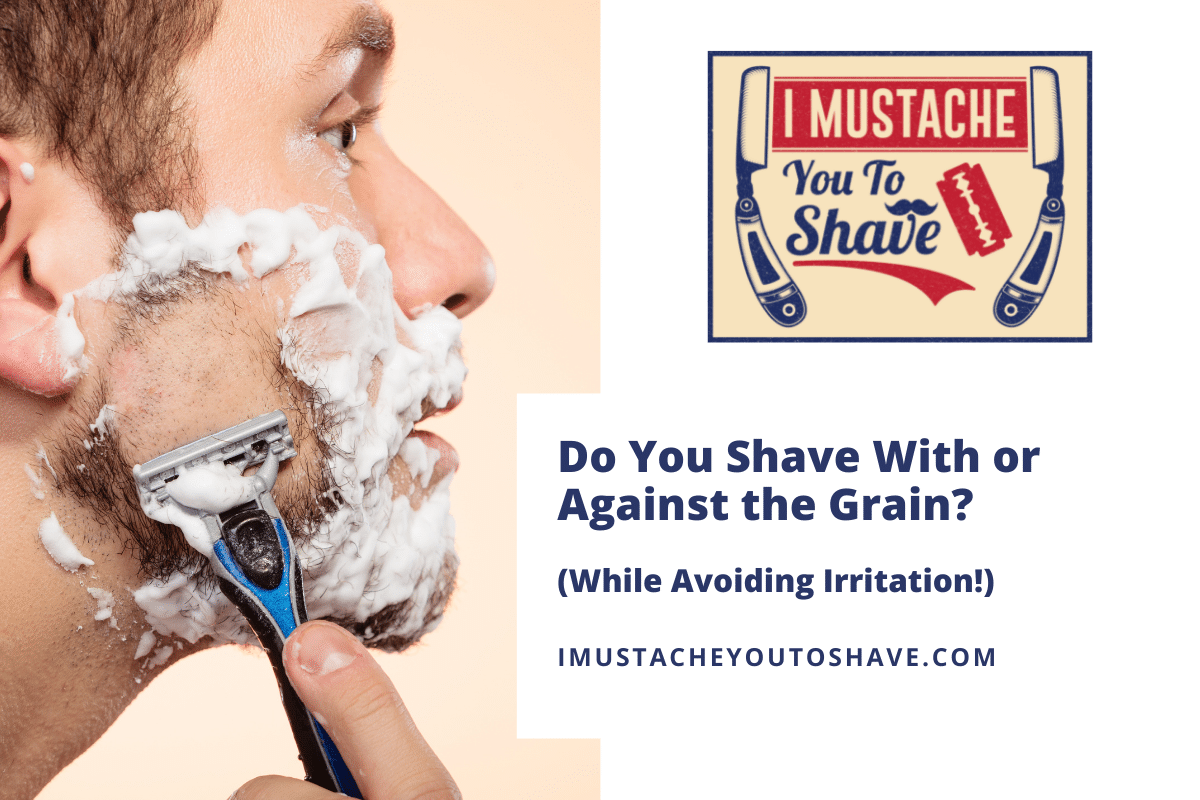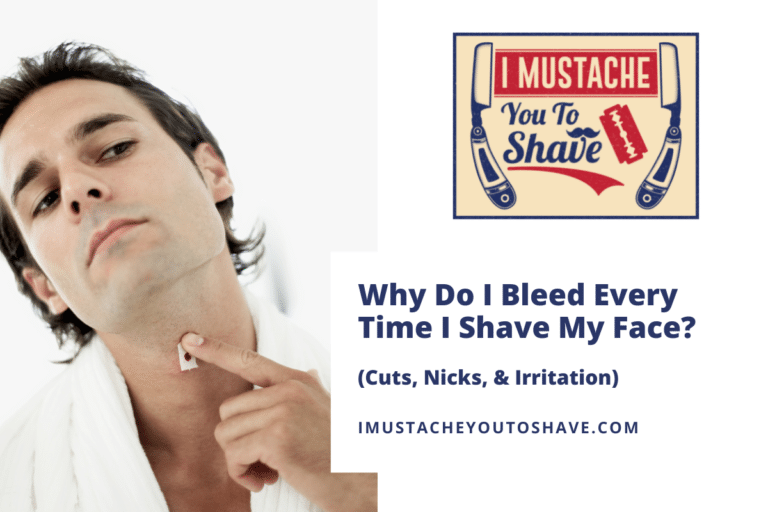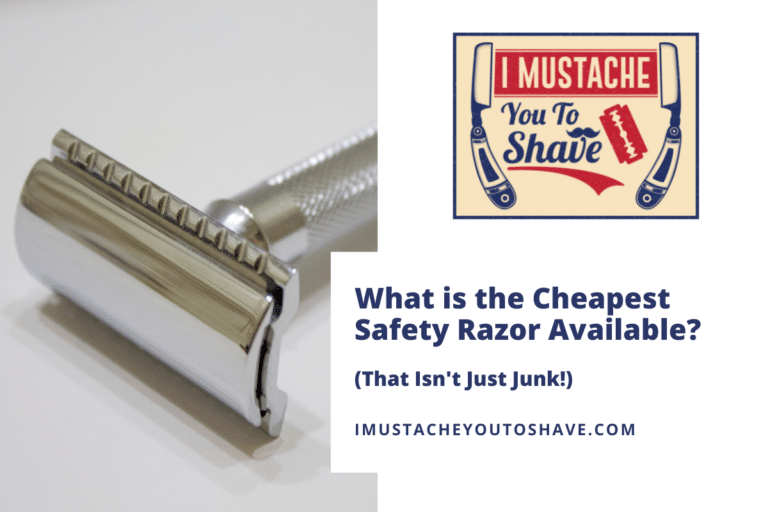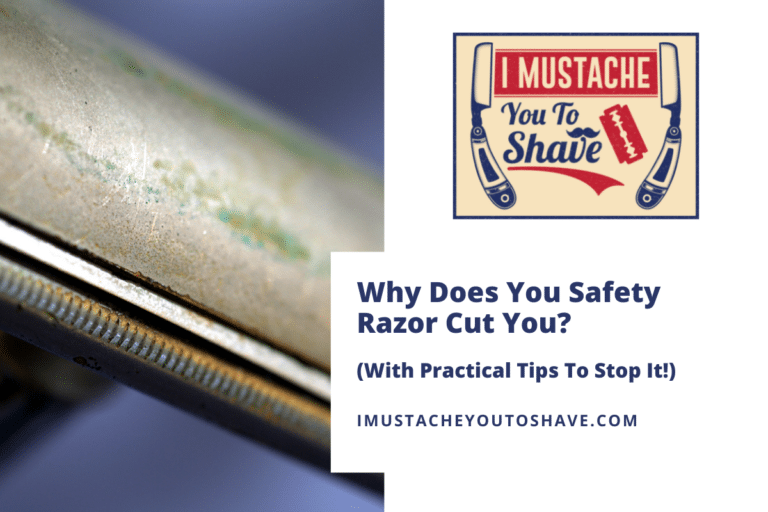Do You Shave With or Against the Grain? (While Avoiding Irritation!)
Shaving can be one of the more relaxing parts of your grooming and skincare routine, but sometimes it feels far from that. After getting your face ready for a clean and close shave, you may find that no matter how many times you shave, you can’t get a clean shave.
Shaving against the grain, drawing the razor blade opposite to the direction that your hair grows, allows the closest shave possible but can cause irritation. Prepare the skin and hair beforehand, apply a quality shaving soap or cream, and use a single-bladed safety razor or straight razor to help avoid irritation when shaving against the grain.
However, using both of these shaving techniques properly can lead to a relaxing and enjoyable shave while giving you a smooth face — no stubble, little irritation, and maximum enjoyment. Be sure to read on to learn how using both of these shaving techniques can transform your shaving experience.
What is Shaving with or Against the Grain?
Shaving with or against the grain refers to the direction you shave in relation to your facial hair. In this section, you’ll learn about the lifecycle of hair, how it impacts shaving, and learn what with-the-grain and against-the-grain mean.
Before you determine whether you should start shaving with or against the grain, take a moment to appreciate the humble hair follicle.
The hair follicle is a shaft in your skin that hair grows out of. The hair itself, made of a protein called keratin, grows out of the hair follicle. Depending on the shape and orientation of the follicle, facial hair can grow in any direction. In fact, facial hair rarely grows straight out and, instead, grows to the left, right, up, or down.
When left to grow on its own, the life cycle of hair can be anywhere from a couple of years to much longer. There are three main phases in hair growth:
- Anagen – This is when your hair is actively growing. This phase can last anywhere from two-to-six years. Scientists believe the length of the anagen phase is genetically determined.
- Catagen – All growth has stopped in the catagen phase. At this point, the hair is sitting in the follicle, detached from its blood supply. This phase lasts two to four weeks.
- Telogen – The hair and follicle are completely dormant. The hair can remain for a few months before it finally sheds. For perspective, 6%-8% of the hair on your scalp is in the telogen phase at any given moment.
So, what’s any of this have to do with shaving with or against the grain?
Now that we’ve established the anatomy of the hair follicle and its growth phases, it’s time to talk about growth patterns.
At the base of each hair follicle, an intricate network of nerves attaches to the bottom of the hair. When you take your hand and rub it against your facial hair, this network of nerves helps indicate that something is touching the hair.
To determine your facial hair growth patterns, you’ll need to utilize these nerves.
Facial Hair Growth Patterns
To understand which direction your facial hair comes in, you’ll need to let your hair grow out. You want your facial hair to be somewhere between stubble and beard, which can take anywhere from three to seven days.
Once your facial hair is coming in, and you can feel the length of it when you brush your hand across your face, take a close look in the mirror. Notice anything about your beard?
That’s right: it grows in many different directions. Facial hair growth patterns are seemingly random. In fact, some men report having facial hair that grows in like a crop circle or cowlick — not the easiest thing to shave!
Every person has a different facial hair growth pattern. For some, shaving may feel fairly straightforward since their hair mostly grows in one direction. For others, though, shaving can be difficult work, especially if they’re trying to avoid shaving against the grain because of sensitive skin!
We’ll get into the specifics of this later, but for now, know that you have a unique facial hair growth pattern that will be key to helping you shave.
With all of the information you’ve learned about hair follicles, facial hair growth patterns, and how to determine what’s with or against the grain, it’s time to tackle the proper shaving technique regarding the grain of your hair.
Should you Shave with or Against the Grain?
When determining whether to shave with or against the grain, it’s important to understand the delicate balance between a close shave and a comfortable shave. This section will go over why you would want to shave with the grain or against the grain.
Do you need a quick shave? Are you okay with a little bit of stubble? Are you prepared to spend an extra five or ten minutes to achieve a flawlessly smooth shave?
In general, shaving against the grain offers the closest possible shave, but you must take special care to prevent irritating the skin or causing issues such as ingrown hair to form.
Let’s break down what happens if you only shave with the grain.
Can you Shave Only with the Grain?
It is possible to shave only with the grain. This will be a mostly comfortable shave since you’re not necessarily pulling on the hairs or cutting them extremely close to the skin.
However, you may find that you need to make many passes if you’re only shaving with the grain. This is because it’s harder for the razor to cut the hair if the hair is pointing away from the razor.
If you’re wondering whether you can get a close shave shaving with the grain, you might want to try shaving in other directions. While it’s totally possible to obtain a close shave only by shaving with the grain, it might take a while.
One way to shave only with the grain a more efficient process is by using a new, sharp razor blade or cartridge. Do not try to use an old razor blade — it may take a rather long time!
Remember, with each additional pass of the razor across your face, you’re removing more oil and skin. Too many passes can irritate the skin, so try to limit your passes to no more than three.
Can you Shave Only Against the Grain?
Trying to shave going against the grain only is a perilous task at best. When you draw the razor against the grain of your hair, you’re taking the most extreme angle against the hair.
Starting with an aggressive angle can irritate the hair follicles. When shaving against the grain, the razor typically “tugs” on the hair first. This sets off irritation in the nerves and increases blood flow to the area. Only after that initial pull does the razor lop the hair off.
In fact, the American Academy of Dermatology Association recommends not shaving against the grain because of the risk of irritation and ingrown hairs.
But if you still want to give shaving against the grain a shot, rest assured that you won’t cause too much damage. Samer Jaber, the director of Washington Square Dermatology, says it really depends on your skin’s sensitivity.
How to Shave Against the Grain without Irritation
In an ideal world, your shaving routine utilizes with the grain and against the grain shaving.
To reduce irritation while also eliminating as much facial hair and stubble, you’ll need to take multiple passes with your razor. Put simply, this means you’re going to lather and shave the same area multiple times.
The benefits of multi-pass shaving are numerous. But most important is that it balances comfort with smoothness.
But if you want to shave against the grain without irritation, it’s important to follow the best shaving practices listed below:
- Learn your facial hair growth pattern
- Prepare your face for shaving
- Apply pre-shave oil
- Utilize proper shaving technique
- Execute a flawless post-shave routine
This may seem like too much information for learning how to shave against the grain without irritation. Just keep reading to see step-by-step how you can get a smooth shave without the pain, heat, and itchiness of razor burn and ingrown hairs.
Take Time to Learn the Grain of Your Facial Hair
Understanding the direction your facial hair grows is key to shaving against the grain. Without knowing the direction, how can you know whether you’re shaving with, across, or against the grain?
To understand which direction your beard hairs grow in, let your facial hair grow out for a few days.
Now that you can visually identify that your hair grows in different directions on your face take some time to feel the different textures your hair has depending on which way you rub it.
Notice a smooth or softer side? You’ve just experienced moving your hand with the grain of your facial hair growth pattern. Do you feel a rough or prickly side? This is called moving against the grain of your facial hair growth pattern.
By now, you’ve probably noticed your facial hair doesn’t grow in one uniform direction. Instead, there’s a confusing swirl of directions and patterns.
At this point, try to remember the general direction your hair grows in certain parts of your face. If it helps, you can create a “map” of which direction your hair grows on your face. You can use this as a reference for shaving against the grain.
For example, a common direction for neck hair to grow in is “up,” as in pointing towards your face. Mark that area with “up” arrows. Meanwhile, the hair above the upper lip typically grows “down,” as in towards your lip. You can denote this with “down” arrows.
Prepare the Face for Shaving
To prepare your face for against the grain shaving with little irritation, take a warm shower or heat your face with a warm towel. This process helps release dirt and oil from your pores.
Once you feel relaxed and your face is wet and warm, apply a cleanser to a damp washcloth. From there, gently rub the cleanser into your face and beard. This helps further remove dirt, oil, and dead skin from your face.
Apply Pre-Shave Oil
Pre-shave oil is an effective way to keep your face moisturized throughout the shaving experience. While shaving soap typically includes plenty of moisturizers and emollients, pre-shave oil really helps your skin stay hydrated, especially after the second or third pass.
Utilize Proper Shaving Technique
Make sure that you form a proper lather with your shave soap. If you’re using a self-foaming shave soap, you don’t need to worry about lathering your soap.
For those of you with soap and brush, make sure that your lather is hydrated and can be whipped to stiff peaks.
Apply your shave soap to your face and begin working it into your facial hair. Feel free to let the shave soap sit on your face for a couple of minutes. This will continue to soften the hairs and relax the follicles.
- Note: While cold water shaving is a viable option in normal circumstances, it can be very discomforting to cold water shave only shaving against the grain. Take caution if you explore these cold waters.
Once you’re ready to start your first pass with the razor, be sure to shave with the grain. On the second pass, shave across the grain. On the third pass, you can go ahead and shave against the grain. If you forget which way your hair grows, don’t hesitate to touch your beard!
Using a sharp, clean, and new blade, apply as little pressure as possible with your razor. You can work in smooth continuous strokes or slow short strokes. Either way, make sure you’re only shaving your face if there is shaving soap on it.
Once you’ve shaved your whole face, determine if you missed any spots. If you took your time and have a good razor, shaving against the grain rarely requires an additional pass. But, if you missed a few spots, lather up and begin shaving again.
Remember, shaving isn’t a race — It’s a time to relax and give yourself the shave you deserve.
Post-Shave Routine
To finish off your against-the-grain shave, you’ll need to take excellent care of your skin.
For starters, rinse your face with cool water. After that, apply your favorite aftershave or moisturizers.
For those with sensitive skin, look for an alcohol-free aftershave. If your skin is especially sensitive, you may need to skip the aftershave and use a moisturizer.
Just remember that the first few minutes after you finish saving are when your skin is most sensitive. It can dry out very quickly, so make sure to apply moisturizer as soon as possible.







